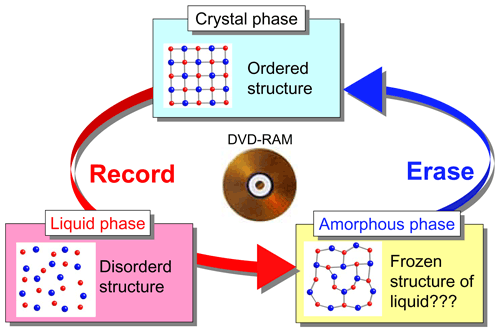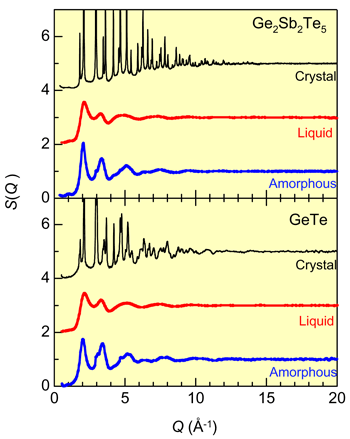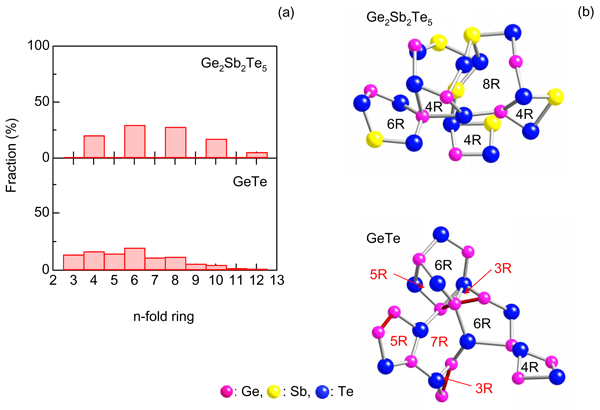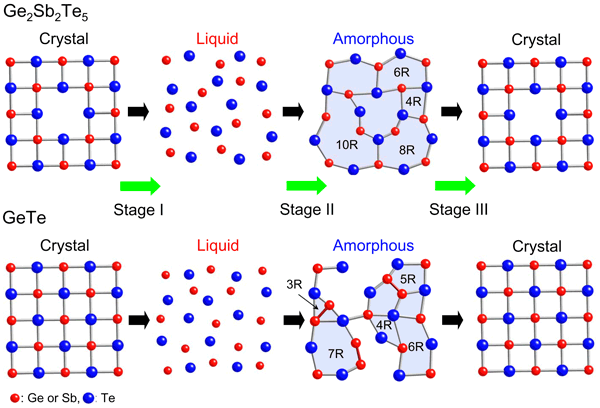Structural basis for the fast phase change of DVD-RAM (Press Release)
- Release Date
- 17 Oct, 2006
- BL02B2 (Powder Diffraction)
- BL04B2 (High Energy X-ray Diffraction)
The research group of Japan Synchrotron Radiation Research Institute (JASRI), RIKEN Harima Institute, Matsushita Electric Industrial Co., Ltd. and University of Tsukuba et al. has discovered the key structure of DVD-RAM, which highly contributes to the improvement of the phase-change speed in the materials. This finding will provide important clues for the design of faster phase-change materials. This work was supported by CREST "X-ray pinpoint structural measurement project - Development of the spatial- and time-resolved structural study for nano-materials and devices -" from Japan Science and Technology Agency (JST).
A new era in phase-change materials was opened by the studies of Chen et al. on GeTe compound, and Yamada and co-workers on Au-Ge-Sn-Te in a single-phase structure. They reported that these materials show a high phase-stability of the amorphous phase and a very short crystallization time. These approaches discovered the way to develop new phase-change rewritable materials and led to the discovery in 1987 of the GeTe-Sb2Te3 single-phase material by Yamada and co-workers. The pseudo-binary compound 2GeTe-Sb2Te3 (Ge2Sb2Te5) is one of the well-established mother materials for commercial DVD-RAM (digital versatile disc - random access memory) device which utilizes the phase change of crystal-liquid-amorphous (record) and amorphous-crystal (erase) in chalcogenide materials (Fig. 1). In order to develop faster phase-change materials, it is necessary to understand the structural origins of the phase change, especially the 3-dimensional structure of the amorphous phase in the phase change from amorphous to crystal. In this study, we derived the 3-dimensional atomic configuration of amorphous Ge2Sb2Te5 (a-Ge2Sb2Te5, crystallization speed: 20 nsec) and amorphous GeTe a-GeTe, crystallization speed: 100 nsec) by reverse Monte Carlo (RMC) computer simulation with synchrotron-radiation X-ray diffraction data.
The high-energy X-ray diffraction experiments were carried out at the SPring-8 High-energy X-ray Diffraction Beamline BL04B2 and Powder Diffraction Beamline BL02B2. The measured data were analyzed by Rietveld analysis and RMC simulation.
Figure 2 shows the measured structure factors S(Q). The diffraction pattern of Ge2Sb2Te5 and GeTe crystals consists of sharp Bragg reflections, indicating the long-range periodicity in the atomic arrangement. On the other hand, the diffraction pattern of Ge2Sb2Te5 (953 K) and GeTe (1073 K) liquids shows a typical halo pattern peculiar to non-crystalline materials. These diffraction patterns show a highly disordered state (liquid state) in which both Ge2Sb2Te5 and GeTe have to undergo during a recording process by a laser-heated melt-quench process.
The ring statistics for the amorphous and crystal Ge2Sb2Te5 and GeTe were calculated up to 12-fold ring as shown in Fig. 3(a) . It is remarkable that a-Ge2Sb2Te5 can be regarded as “even-numbered rings structure”, because the ring statistics is dominated by 4- and 6-fold rings analogous to the crystal phase. On the other hand, we find that a-GeTe has various size (both odd- and even-numbered) rings. These differences in the network of the ring structure are clearly visible in 3-dimensional atomic configurations obtained from the RMC simulation as shown in Fig. 3(b).
From the comparison of the ring statistics, the mechanism of fast crystal-liquid-amorphous (record) and amorphous-crystal (erase) phase changes in Ge2Sb2Te5 are proposed by the schematic presentation as shown in Fig. 4. In the crystal-liquid phase-change process (stage I), atomic configuration in the crystal phase is disarranged by the laser heating and melted in liquid, where there is no significant structural difference between Ge2Sb2Te5 and GeTe (see also Fig. 2). Meanwhile in the liquid-amorphous phase-change process (stage II), only even-numbered rings are constructed in a-Ge2Sb2Te5. In the amorphous-crystal phase-change process (stage III), a-Ge2Sb2Te5 transforms to the crystal phase due to the transformation of only the large-size even-numbered (8, 10, 12-fold) rings into crystal structure (4- and 6-fold rings). On the other hand, a-GeTe exhibits various size (both odd- and even-numbered) rings in stage II. Therefore the recombination of the various size rings is required in stage III. Thus the construction of odd-numbered rings in a-GeTe disturbs the fast crystallization of the amorphous phase, and it is worth mentioning that the addition of Sb2Te3 to GeTe can effectively prevent the formation of odd-numbered rings in a-Ge2Sb2Te5. We believe such an unusual ring statistics of amorphous Ge2Sb2Te5 is the key for the fast crystallization speed of the material.
<<Figures>>
This work was conducted by Dr. Masaki Takata (RIKEN Harima Institute), Dr. Shinji Kohara (Japan Synchrotron Radiation Research Institute), Dr. Noboru Yamada (Matsushita Electric Industrial Co., Ltd.) and Prof. Yutaka Moritomo (University of Tsukuba) et al. and will be presented in the following conference.
International Symposium on Optical Memory 2006
"RMC Analyses Solve High-Speed Phase-Change Mechanism"
T. Matsunaga, R. Kojima, N. Yamada, S. Kohara, M. Takata
This work will be published in the following article:
Applied Physics Letters, 89, 201910 (2006), published online 17 November 2006.
"Structural basis for the fast phase change of Ge2Sb2Te5: Ring statistics analogy between the crystal and amorphous states"
Shinji Kohara, Kenichi Kato, Shigeru Kimura, Hitoshi Tanaka, Takeshi Usuki, Kentaro Suzuya, Hiroshi Tanaka, Yutaka Moritomo, Toshiyuki Matsunaga, Noboru Yamada, Yoshihito Tanaka, Hiroyoshi Suematsu, and Masaki Takata
For more information, please cnotact Dr. Masaki Takata (RIKEN Harima Institute):
E-mail: takatama@spring8.or.jp
Phone & Fax: +81-(0)791-58-0946
- Current article
- Structural basis for the fast phase change of DVD-RAM (Press Release)



